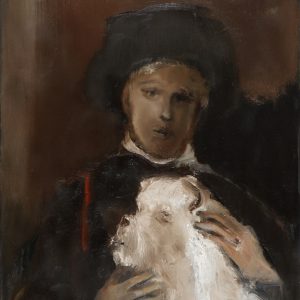Description
Artist/Maker: Alekos Fassianos (b. 1935)
Object/Materials and Techniques: Oil on Canvas
Dimensions: H. 70 cm. x L. 55 cm.
Art style: Pop Art with influences from Byzantine Art and Fauvism
Signature: Signed in English (upper left)
Current Location: Private collection
Curator’s note: Across the span of almost 7 decades of prodigious creativity, Alekos Fassianos has earned a historical place among the global artistic world. Deemed as one of the most preeminent painters of modern life in Hellas, not only did he fundamentally contribute to the growth of the Hellenic Modern Art but he also exerted an impact on later artistic expression and cultural production in general.
Alekos Fassianos carried this special quality of being widely admired, accepted and sought after. Even today, on one hand, his name, so broadly circulated, with almost everyone knowing it, still remains a vibrant part of the current art discourse. On the other hand, his work, nearly unanimously appreciated due to its distinctive style and iconography, upholds such a timeless value, with strong status behind, that someone could say as if the artist reinforced the public view through the creation of a stand-out brand for himself and his workmanship.
Actually, much of the aforementioned reputation and status attributed to him derived from his constant engagement in the ‘developing, nurturing and promoting’ (Schroeder, 2005: 130) his own art, becoming distinguished as a name. Alike Andy Warhol who was the first artist and the major influence behind the popularity of art, Alekos Fassianos, all the way up to his passing, didn’t stop producing art by large amounts. Except for the main corpus of his work which was so excessive in extent and force as to elicit awe, issued work onto different kind of objects to be sold as a commodity, or mission-specific art pieces, created upon various occasions, gave rise to the beyond-any bounds popularity of his art creation. His name became indisputably everlasting, both in Hellas and abroad, while his images, along with the portraits included, turned out to be unforgettable icons of ominous significance, immortalized in popular culture.
His strength further rested in the fact that, throughout his artistic career, he encompassed something unique about his art by formulating a genuine and particularly distinguishable personal aesthetic vernacular. He was widely involved in a kind of Expressionism-based practice, gently merged with Hellenic folk art references and decorative motifs reflective of popular, tradition-focused depictions.
Upholding the pride of his Hellenic origin, and maintaining the respect of the colossal cultural heritage of his home country, he employed a Byzantine attitude mainly based on sophisticated aesthetics. Correspondingly to Byzantine modes of style that were partly evolved from the predecessor classical Hellenic mythology, marked by a meaningful and deeply symbolic approach, Alekos Fassianos’ oeuvre relies on the applied expressive forces of both artistic contents.
Moreover, within the process of fashioning this sharply characteristic style, his artistic language was stirred up by the study of the ‘grand saga’ of the European civilization and heritage -derived from the antique times down to modern era- with all its edifying cultural assets, principles, rules and interpretations encompassed. in fact, unlike other Hellene artists of his generation, and although he spent great time in Paris, none of the European avant-garde movements of the time were clearly adopted or purely taken up into practice by him. Instead, Alekos Fassianos’ attraction to European culture and civilization was incorporated in an unceremonious interaction with the viewer pointing to remembrances and truths from the elapsed time, the present-day and the time ahead.
Someone could say that he drew a parallel between surrealist insights and a sort of expressionist Abstraction, masterfully succeeding in converting imageries of cultural state of affairs, recorded away below the level of our consciousness, and relied upon the high-spiritedness and the exuberance of an imaginary story.
In this light, the audience have been experiencing the artist’s emblematic style of acuity and sharpness in perception upon an informal negotiation with theatricality. Canvasses rich in seductively lively forms and dreamy details, unfolded within a powerful and vivid chromatic scheme, all feature a hauntingly beautiful kind of mythology that takes place in a fanciful world, nearly equal to a fairy-tale, filled with signs and icons of popular culture. French art critic & historian, Pierre Cabanne writes ‘He lives in a mythic world‘. Even those paintings that are describing objects or venues stemmed from reality are more than just representations of everyday life. Rather, they often suggest fabled influences with a direct reference to the visionary world of the Hellenic mythology.
But above all, being primarily anthropocentric and having portraiture as starting point, his compositions were developed upon the conception of human figure. More specifically, having a visual identity to go along with a plain, uncomplicated form and repeated use, Alekos Fassianos’ figures exert such a powerful attraction that up to date captivate the viewer at once. They became broadly and immediately recognizable, not to mention the symbol the artist is best known for.
At first they may appear naive and childlike however they transcend themselves to become universal, emblematic and completely unaffected by time. They overcame their initial deliberate simplicity, and gradually progressed and become dominant and pulsated presences within their space that push outward both their image and appeal. Lively vigorous and at the same time elegiastically articulated and structured, they look dreamlike since they carry more of a poetic than a realistic sensation. Despite their minimal and flat drawing style, they rhythmically expand and contract, giving off their cosmic energy and grandeur. Inevitably, Alekos Fassianos’ celebrated human figures were being converted into allegorical visages yet archetypical and iconic.
In this sense, ‘Le créateur des étoiles‘, placed diligently but informally onto space, tends to entice into a desired action and state. The theatrical magnetism of the figure in accordance with the intense red color and the dispersed mythological elements enhance an overall sense of impressive monumentality attributing to the composition of a mythical allure where the tangible reality comes across utopia. The central character interlaces in an elegiac net as he balances between nature and spirituality, between the reality and a reverie, between a real fact and a childlike vision. This sense of balance befalls upon what one would think of a stage with the figure acting as if in the epicenter of a performance.
Even more, notable is the artist’s characteristic emphasis on the inscribed title of the work on the canvas. The written text element creates both interconnected emotions and reflective connotations for the viewer who becomes involved with the sensitive nature of the figure, particularly when sharing the same fondness for stars. Likely taken from memories and realities of life and special lifetime instants, the artist offers thought-provoking starting points as he draws attention upon the intensity in personal moments.
In all stages of his work, the stress on painterly artistic values divulges the artist’s deep bond with the genuine assets of art-creating. Even today, his ‘brand’ of vibrant quality and esthetic supremacy brings to the fore the exceptionality of his oeuvre which, in turn, catalytically conduces to the advance and enhancement of the Hellenic art production.
Indisputably, Alekos Fassianos became one of the most distinctive figures of all ages upon the Hellenic artistic scene with his works still acting as the ultimate inheritance and a major reference point, not only for the Hellenic Modern art but respectively for the worldwide Modern art, against any crushing passage of time.





